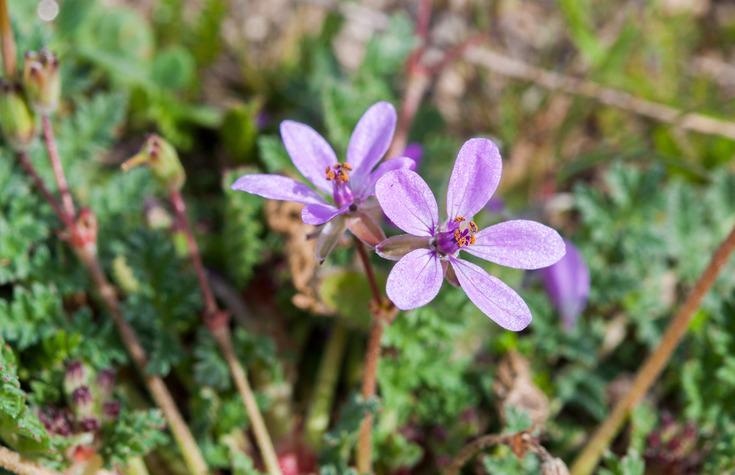New research performed at the University of California (UC Riverside) has highlighted the fact that it is not how much water a plant is given that determines how well it grows, but when the it is given.
 Erodium cicutarium, a winter-blooming wildflower in the California desert. Image Credit: (IHervas/iStock/Getty Images Plus).
Erodium cicutarium, a winter-blooming wildflower in the California desert. Image Credit: (IHervas/iStock/Getty Images Plus).
This is particularly true near Palm Springs, where the research group made artificial rainfall to analyze its effects on plants for two years. This region consists of both summer and winter growing seasons, both of which are increasingly affected by drought and, at times by, extreme rain events.
Some desert wildflowers and grasses typically start growing in December and die around June time. In July, the second community of plants emerges, blooming in August. Wildflowers, for example, are a very popular tourist attraction during the “super bloom” years.
We wanted to understand whether one season is more sensitive to climate change than another. If we see an increase or decrease in summer rains, or winter rains, how does that affect the ecosystem?
Marko Spasojevic, Study Lead Author and Plant Ecologist, University of California Riverside
The researchers noted that in summer, plants tend to grow more while giving extra water, in addition to any natural rainfall. But the same was not the case in winter.
Spasojevic stated, “Essentially, adding water in summer gets us more bang for our buck.”
Their study outcomes are explained in a paper reported in the University of California journal Elementa.
While the study was in progress, the researchers noted around 24 plots of land at the Boyd Deep Canyon Desert Research Center in the Palm Desert area. A few of the plots got whatever rain naturally dropped. The rest were covered and enabled to receive rain in just one given season. The third group of plots were given additional collected rainwater.
During summer, the addition of water led to greater plant biomass and it usually did not increase the diversity of plants that showed growth. This phenomenon was noted by scientists. In contrast, the reduction of rainfall had negative impacts on plants throughout both the summer and winter seasons, but may result in some increased growth in the subsequent off-season.
The work’s implications expand beyond learning when extra water resources may be applied just to help plant growth. Entire communities of animals rely on these plants. They are crucial for pollinators like butterflies and bees, and they play a major role in regulating the movement and erosion of soils by the wind.
Studies like this one are critical for understanding the complex effects of climate change on dryland ecosystems.
Darrel Jenerette, Study Co-Author and Landscape Ecologist, University of California Riverside
Also, desert plants play a significant role in eliminating nitrogen and carbon dioxide from the air to use as fuel for growth. Microbes that survive in the soil could utilize the carbon and nitrogen liberated by plant roots, then send it back into the air where it can cause harm to the climate.
Drylands cover roughly a third of the land surface, so even small changes in the way they take in and emit carbon or nitrogen could have a big impact on our atmosphere.
Peter Homyak, Study Co-Author and Environmental Scientist, University of California Riverside
In the next few years, the researchers are planning to continue this research and are expecting to notice changes in nitrogen cycling and soil carbon. Also, as this study displays, the plants are already being impacted by changes caused by seasonal rainfall.
“Can changes in precipitation patterns alter the feedback between plants and microbes, destabilizing the carbon locked in soils and sending more of it into the atmosphere? We are working on figuring that out,” stated Homyak.
Journal Reference:
Spasojevic, M. J., et al. (2022) Altered precipitation has asymmetric impacts on annual plant communities in warm and cool growing seasons. Elementa: Science of the Anthropocene. doi.org/10.1525/elementa.2021.00014.